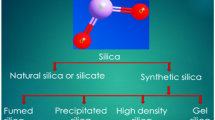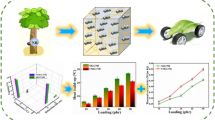Abstract
Tyres made of natural rubber (NR) filled with silica (SiO2) are usually called energy-saving tyres with excellent resistance to wet slip and low friction resistance. It’s noted that the tyres tend to aging and produce static electricity caused by poor electrical and thermal conductivity of NR and SiO2. Therefore, it’s urgent to prepare NR/SiO2 composites with enhanced thermal conductivity and antistatic performance. Here, a simple, efficient, and green method is applied to obtain graphene nanosheets (GNs) compatible well with NR, and the influence of GNs dosage on the properties of SiO2/NR composites are explored. The results show that GNs are helpful to improve mechanical properties and solvent resistance of SiO2/NR composites. Outstandingly, the thermal conductivity and electrical conductivity of 2.0wt%GNs/SiO2/NR composites are increased by 60% and 5 orders of magnitude compared with SiO2/NR composites, reaching to 0.29W·m-1·K-1 and 4.2×10-8 S/m respectively. It’s expected that GNs can become a candidate for improving thermal conductivity and antistatic properties of energy-saving tyres.












Similar content being viewed by others
References
Tabsan N, Wirasate S, Suchiva K (2010) Abrasion behavior of layered silicate reinforced natural rubber. Wear 269(5–6):394–404
Liu C, Shao Y, Jia D (2008) Chemically modified starch reinforced natural rubber composites. Polymer 49(8):2176–2181
Omnès B, Thuillier S, Pilvin P, Grohens Y, Gillet S (2008) Effective properties of carbon black filled natural rubber: Experiments and modeling. Compos - A: Appl Sci Manuf 39(7):1141–1149
Bockstal L, Berchem T, Schmetz Q, Richel A (2019) Devulcanisation and reclaiming of tires and rubber by physical and chemical processes: a review. J Clean Prod 236:117574
Fragiadakis D, Bokobza L, Pissis P (2011) Dynamics near the filler surface in natural rubber-silica nanocomposites. Polymer 52(14):3175–3182
Payne AR (1962) The dynamic properties of carbon black‐loaded natural rubber vulcanizates. Part I. J Appl Polym Sci 6(21):368-372
Ruiz MR, Cabreira PLS, Budemberg ER, Reis EAPd, Bellucci FS, Job AE (2016) Chemical evaluation of composites natural rubber/carbon black/leather tannery projected to antistatic flooring. J Appl Polym Sci 133(27):43618
Layek RK, Nandi AK (2013) A review on synthesis and properties of polymer functionalized graphene. Polymer 54(19):5087–5103
Li J, Yan Q, Zhang X, Zhang J, Cai Z (2019) Efficient Conversion of Lignin Waste to High Value Bio-Graphene Oxide Nanomaterials. Polymers 11(4):623
Araby S, Meng Q, Zhang L, Kang H, Majewski P, Tang Y (2014) Electrically and thermally conductive elastomer/graphene nanocomposites by solution mixing. Polymer 55(1):201–210
Mcallister MJ, Li JL, Adamson DH (2007) Single sheet functionalized graphene by oxidation and thermal expansion of graphite. Chem Mater 19(18):4396–4404
Zhao S, Xie S, Liu X, Shao X, Zhao Z, Xin Z (2018) Covalent hybrid of graphene and silicon dioxide and reinforcing effect in rubber composites. J Polym Res 25(10):255
Yang B, Zhang S-H, Zou Y-F, Ma W-S, Huang G-J, Li M-D (2018) Improving the Thermal Conductivity and Mechanical Properties of Two-component Room Temperature Vulcanized Silicone Rubber by Filling with Hydrophobically Modified SiO2-Graphene Nanohybrids. Chin J Polym Sci 37(2):189–196
Charoenchai M, Tangbunsuk S, Keawwattana W (2020) Silica-graphene oxide nanohybrids as reinforcing filler for natural rubber. J Polym Res 27(8):230
Ye X, Guo J, Zeng X (2017) Antistatic effects and mechanism of ionic liquids for methyl vinyl silicone rubber. J Appl Polym Sci 134(32):45180
Frasca D, Schulze D, Wachtendorf V, Huth C, Schartel B (2015) Multifunctional multilayer graphene/elastomer nanocomposites. Europ Polym J 71:99–113
Ramanathan T, Abdala AA, Stankovich S, Dikin DA, Herrera-Alonso M, Piner RD (2008) Functionalized graphene sheets for polymer nanocomposites. Nat Nanotechnol 3(6):327–331
Singh VK, Shukla A, Patra MK, Saini L, Jani RK, Vadera SR (2012) Microwave absorbing properties of a thermally reduced graphene oxide/nitrile butadiene rubber composite. Carbon 50(6):2202–2208
Long Y, Wang JF, Lv YN, Tao CA, Xia L, Zhu H (2012) Preparation and Characterization of Graphene by the Oxidation Reduction Method. Adv Mat Res 554-556:624-627
Matos CF, Galembeck F, Zarbin AJG (2014) Multifunctional and environmentally friendly nanocomposites between natural rubber and graphene or graphene oxide. Carbon 78:469–479
Punith Kumar MK, Nidhi M, Srivastava C (2015) Electrochemical exfoliation of graphite to produce graphene using tetrasodium pyrophosphate. RSC Advances 5(32):24846–24852
Li J, Zhao X, Wu W, Zhang Z, Xian Y, Lin Y (2020) Advanced flexible rGO-BN natural rubber films with high thermal conductivity for improved thermal management capability. Carbon 162:46–55
Lin Y, Liu S, Peng J, Liu L (2016) The filler–rubber interface and reinforcement in styrene butadiene rubber composites with graphene/silica hybrids: A quantitative correlation with the constrained region. Compos - A: Appl Sci Manuf 86:19–30
Song Y, Yu J, Dai D, Song L, Jiang N (2014) Effect of silica particles modified by in-situ and ex-situ methods on the reinforcement of silicone rubber. Mater Des 64:687–693
Fu W, Wang L (2016) Research on Payne effect of natural rubber reinforced by graft-modified silica. J Appl Polym Sci 133(36):43891
Lin Y, Chen Y, Zeng Z, Zhu J, Wei Y, Li F (2015) Effect of ZnO nanoparticles doped graphene on static and dynamic mechanical properties of natural rubber composites. Compos - A: Appl Sci Manuf 70:35–44
Kang H, Tang Y, Yao L, Yang F, Fang Q, Hui D (2017) Fabrication of graphene/natural rubber nanocomposites with high dynamic properties through convenient mechanical mixing. Compos B Eng 112:1–7
Aguilar-Bolados H, Brasero J, Lopez-Manchado MA, Yazdani-Pedram M (2014) High performance natural rubber/thermally reduced graphite oxide nanocomposites by latex technology. Compos B Eng 67:449–454
Stanier DC, Patil AJ, Sriwong C, Rahatekar SS, Ciambella J (2014) The reinforcement effect of exfoliated graphene oxide nanoplatelets on the mechanical and viscoelastic properties of natural rubber. Compos Sci Technol 95:59–66
Papageorgiou DG, Kinloch IA, Young RJ (2015) Graphene/elastomer nanocomposites. Carbon 95:460–484
Xu X, Hu R, Chen M, Dong J, Xiao B, Wang Q (2020) 3D boron nitride foam filled epoxy composites with significantly enhanced thermal conductivity by a facial and scalable approach. Chem Eng J 397:125447
Hu J, Ruan X, Chen YP (2009) Thermal conductivity and thermal rectification in graphene nanoribbons: a molecular dynamics study. Nano Lett 9(7):2730–2735
Zhu T, Ertekin E (2016) Phonons, Localization, and Thermal Conductivity of Diamond Nanothreads and Amorphous Graphene. Nano Lett 16(8):4763–4772
Li Y, Xu F, Lin Z, Sun X, Peng Q, Yuan Y (2017) Electrically and thermally conductive underwater acoustically absorptive graphene/rubber nanocomposites for multifunctional applications. Nanoscale 9(38):14476–14485
Zhan Y, Lavorgna M, Buonocore G, Xia H (2012) Enhancing electrical conductivity of rubber composites by constructing interconnected network of self-assembled graphene with latex mixing. J Mater Chem 22(21):10464–10468
Abu-Abdeen M, Elamer I (2010) Mechanical and swelling properties of thermoplastic elastomer blends. Mater Des 31(2):808-815
Tang Z, Zhang L, Feng W, Guo B, Liu F, Jia D (2014) Rational Design of Graphene Surface Chemistry for High-Performance Rubber/Graphene Composites. Macromolecules 47(24):8663–8673
Liu Q, Shi W, Chen Z (2019) Rubber fatigue life prediction using a random forest method and nonlinear cumulative fatigue damage model. J Appl Polym Sci 137(14)
Dong B, Liu C, Zhang L, Wu Y (2015) Preparation, fracture, and fatigue of exfoliated graphene oxide/natural rubber composites. RSC Adv 5(22):17140–17148
Rooj S, Das A, Thakur V, Mahaling RN, Bhowmick AK, Heinrich G (2010) Preparation and properties of natural nanocomposites based on natural rubber and naturally occurring halloysite nanotubes. Mater Des 31(4):2151–2156
Varghese TV, Ajith Kumar H, Anitha S, Ratheesh S, Rajeev RS, Lakshmana Rao V (2013) Reinforcement of acrylonitrile butadiene rubber using pristine few layer graphene and its hybrid fillers. Carbon 61:476–486
Zhong B, Jia Z, Dong H, Luo Y, Jia D, Liu F (2017) One-step approach to reduce and modify graphene oxide via vulcanization accelerator and its application for elastomer reinforcement. Chem Eng J 317:51–59
Acknowledgments
This study was funded by National Natural Science Foundation of China (51563002), Guizhou Province “100 levels” innovative talent project ([2016]5653), Natural Science Foundation of Guizhou Province (No. 2017[2017], and Research of SBR rubber special materials for low heat generation engineering tire (Qianke Cooperation Support [2018] 2184).
Author information
Authors and Affiliations
Corresponding authors
Ethics declarations
Competing interests
The authors declare that they have no conflict of interest.
Additional information
Publisher's Note
Springer Nature remains neutral with regard to jurisdictional claims in published maps and institutional affiliations.
Rights and permissions
About this article
Cite this article
Gu, X., Qin, H., Wang, C. et al. Enhanced thermal conductivity and antistatic property of energy-saving tyres. J Polym Res 28, 420 (2021). https://doi.org/10.1007/s10965-021-02768-8
Received:
Accepted:
Published:
DOI: https://doi.org/10.1007/s10965-021-02768-8




